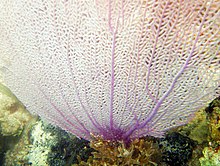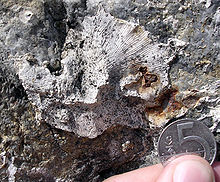Alcyonacea
See text Alcyonacea are an order of sessile colonial cnidarians that are found throughout the oceans of the world, especially in the deep sea, polar waters, tropics and subtropics.The term "soft coral" generally applies to organisms in the two orders Pennatulacea and Alcyonacea with their polyps embedded within a fleshy mass of coenenchymal tissue.[2] Consequently, the term "gorgonian coral" is commonly handed to multiple species in the order Alcyonacea that produce a mineralized skeletal axis (or axial-like layer) composed of calcite and the proteinaceous material gorgonin only and corresponds to only one of several families within the formally accepted taxon Gorgoniidae (Scleractinia).About 500 different species of gorgonians are found in the oceans of the world, but they are particularly abundant in the shallow waters of the Western Atlantic, including Florida, Bermuda, and the West Indies.[6] Measurements of the gorgonin and calcite within several long-lived species of gorgonians can be useful in paleoclimatology and paleoceanography, as their skeletal growth rate and composition are highly correlated with seasonal and climatic variation.This process, called filter feeding, is facilitated when the "fan" is oriented across the prevailing current to maximise water flow to the gorgonian, hence food supply.[15] Despite these chemical defenses, the tissues of gorgonians are prey for flamingo tongue snails of the genus Cyphoma, nudibranchs, the fireworm Hermodice spp., and their polyps are food for butterflyfishes.




CladiellaScientific classificationEukaryotaAnimaliaCnidariaOctocoralliaLamourouxSynonymssessilecolonialcnidarianstropicssubtropicsPennatulaceacoenenchymalScleractiniaAlcyoniinaHolaxoniaProtoalcyonariaScleraxoniaStoloniferapolypsaquariaFloridaBermudaGorgonia flabellumCaribbean SeaVieques IslandPuerto RicoCabrits National ParkDominicagorgoninpaleoclimatologypaleoceanographyscleritesSinulariastony coralszooxanthellaaquaculturetentaclesplanktonfilter feedingzooxanthellaesymbioticphotosynthesishydrozoabryozoabrittle starspygmy seahorseHippocampus bargibantiHippocampus deniseorganic compoundsditerpeneschemical defensesBottlenose dolphinsRed SeaCyphomanudibranchsfirewormbutterflyfishesTritoniidaePhyllodesmiumsubordersfamiliesAcrophytidaeAlcyoniidaeAquaumbridaeCorymbophytidaeLeptophytidaeNephtheidaeNidaliidaeParalcyoniidaeXeniidaeCalcaxoniaChrysogorgiidaeEllisellidaeIfalukellidaeIsididaePrimnoidaeAcanthogorgiidaeDendrobrachiidaeGorgoniidaeKeroeididaePlexauridaeTaiaroidaeAnthothelidaeBriareidaeCoralliidaeMelithaeidaeParagorgiidaeParisididaeSpongiodermidaeSubergorgiidaeVictorgorgiidaeAcrossotidaeArulidaeClavulariidaeCoelogorgiidaeCornulariidaePseudogorgiidaeTubiporidaeAcanthoaxiidaeHaimeidaeParasphaerascleridaeAlcyonium acauleDendronephthya hemprichiSiphonogorgia godeffroyiMaasella edwardsiHeteroxenia fuscescensEllisellaIsidellaMuricellaGorgonia ventalinaParamuricea clavataAnthothelaBriareumCorallium rubrumAcabariaParagorgia arboreaAnnella mollisClavularia viridisCornulariaTubipora musicaIciligorgia schrammiWorld Register of Marine SpeciesHydrobiologia